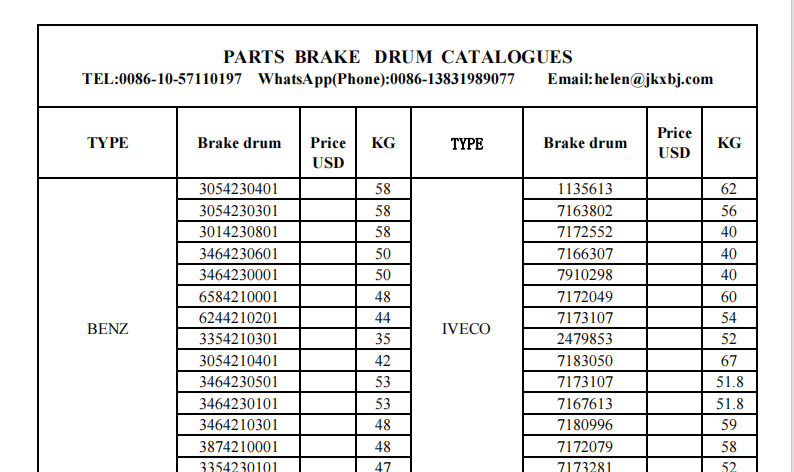Dec . 29, 2024 11:36 Back to list
removing a brake drum
Removing a Brake Drum A Step-by-Step Guide
Removing a brake drum can be a daunting task for many vehicle owners, but with the right tools and a bit of knowledge, it can be accomplished efficiently and safely. Brake drums play a critical role in the braking system of many vehicles, particularly in older models and certain types of trucks. Understanding how to remove them properly is essential for maintenance and repairs. In this article, we’ll walk through the process of removing a brake drum step by step.
Tools You Will Need
Before starting, gather all necessary tools and materials. You will typically need
- A jack and jack stands - A lug wrench - A brake drum removal tool (if applicable) - A hammer or rubber mallet - A socket set - A flat-head screwdriver - Safety goggles and gloves
Step 1 Preparation
1. Safety First Ensure the vehicle is parked on a flat surface. Engage the parking brake and wear your safety goggles and gloves to protect yourself from debris.
2. Loosen the Lug Nuts Use the lug wrench to slightly loosen the lug nuts of the wheel that you will be working on. It’s easier to do this while the wheel is still on the ground.
3. Lift the Vehicle Once the lug nuts are loose, use the jack to lift the vehicle. Make sure it is secured with jack stands before proceeding. This will ensure your safety while you work.
Step 2 Remove the Wheel
4. Take off the Wheel With the vehicle securely supported, remove the lug nuts completely and take off the wheel to expose the brake drum.
Step 3 Inspect the Brake Drum Assembly
removing a brake drum

5. Examine the Components Before removing the drum, take a close look at the components, including the brake shoes, springs, and other hardware. Understanding how everything is positioned will help you later when reassembling.
6. Check for Access Holes Some brake drums have access holes where you can adjust the brake shoes’ position. If your drum has these, you might want to use a flat-head screwdriver to retract the shoes slightly before attempting to remove the drum.
Step 4 Removing the Brake Drum
7. Remove Any Retaining Screws If the brake drum is held in place by any retaining screws, use your socket set to remove them.
8. Apply Penetrating Oil If the brake drum appears to be rusted or stuck, apply a penetrating oil around the hub area and allow it to sit for a few minutes. This will help loosen any corrosion.
9. Use a Hammer or Mallet Gently tap the drum with a hammer or rubber mallet to encourage it to loosen. Do this in a circular manner around the edge of the drum. Avoid hitting it too hard, as this could cause damage.
10. Pull the Drum Off Once it’s loose, pull the drum directly off the wheel hub. If it won't budge, inspect again for any additional retaining clips or components that may be holding it in place.
Step 5 Final Steps
11. Inspect the Brake Components Once the drum is removed, take the opportunity to inspect the brake shoes, drum interior, and hardware for any signs of wear or damage. This might be a good time to perform maintenance like replacing the brake shoes.
12. Reinstallation When you're finished, the reinstallation of the brake drum is essentially the reverse of the removal. Make sure to properly align everything and secure all nuts and screws adequately.
Conclusion
Removing a brake drum is a straightforward process that can enhance your understanding of your vehicle’s braking system. With careful preparation and attention to detail, this task can be completed safely at home. Regular maintenance, including brake drum inspection and removal, can help ensure your vehicle is running smoothly and safely on the roads. Always consult your vehicle's service manual for specifications and any model-specific instructions. Happy repairing!
-
ROR Web Development: Build Fast, Scalable, Secure Apps
NewsAug.17,2025
-
Scania Brake Drums: OEM Quality for Optimal Safety & Durability
NewsAug.16,2025
-
R.V.I: Advanced Remote Visual Inspection for Precision
NewsAug.15,2025
-
Discover HYUNDA: Innovative Vehicles, Equipment & Solutions
NewsAug.14,2025
-
R.V.I: Unlock Advanced Insights & Real-time Performance
NewsAug.13,2025
-
Kamaz Brake Drum: Durable & Reliable for Heavy Duty Trucks
NewsAug.12,2025
